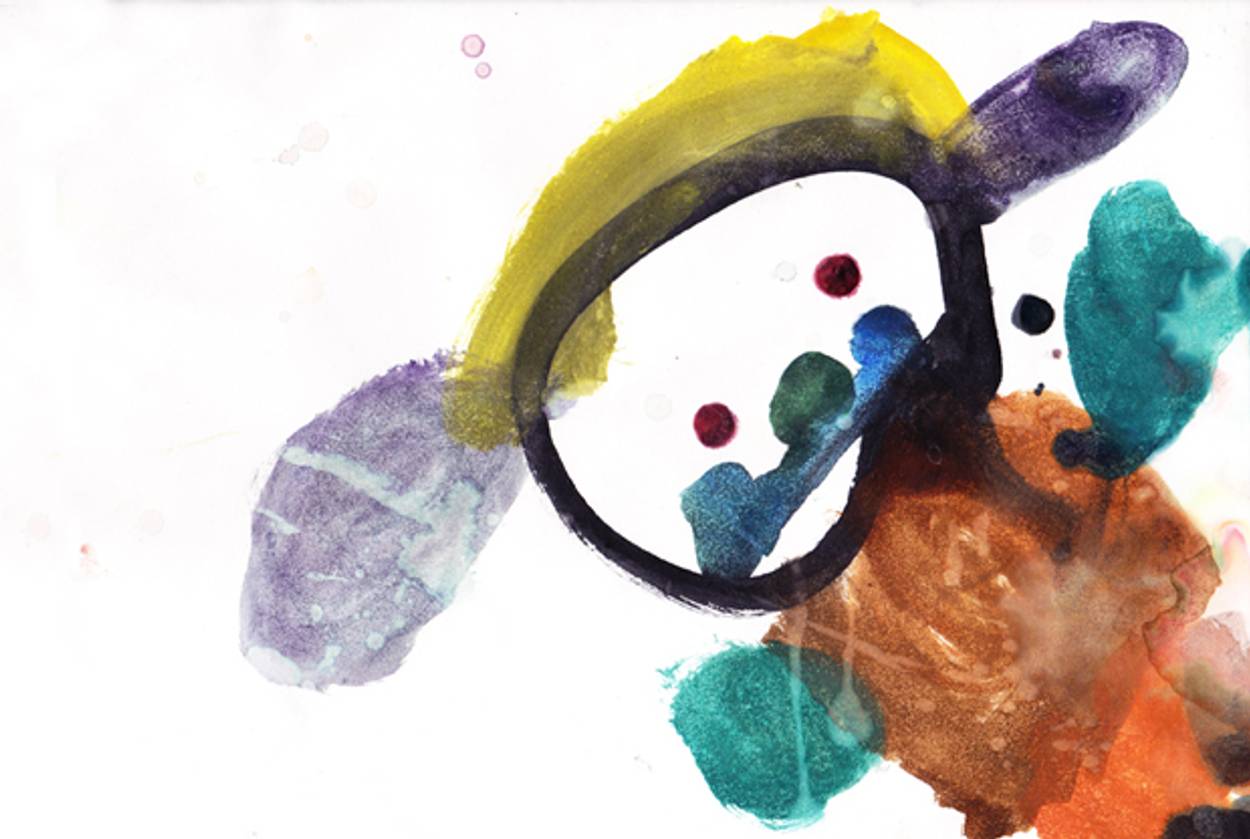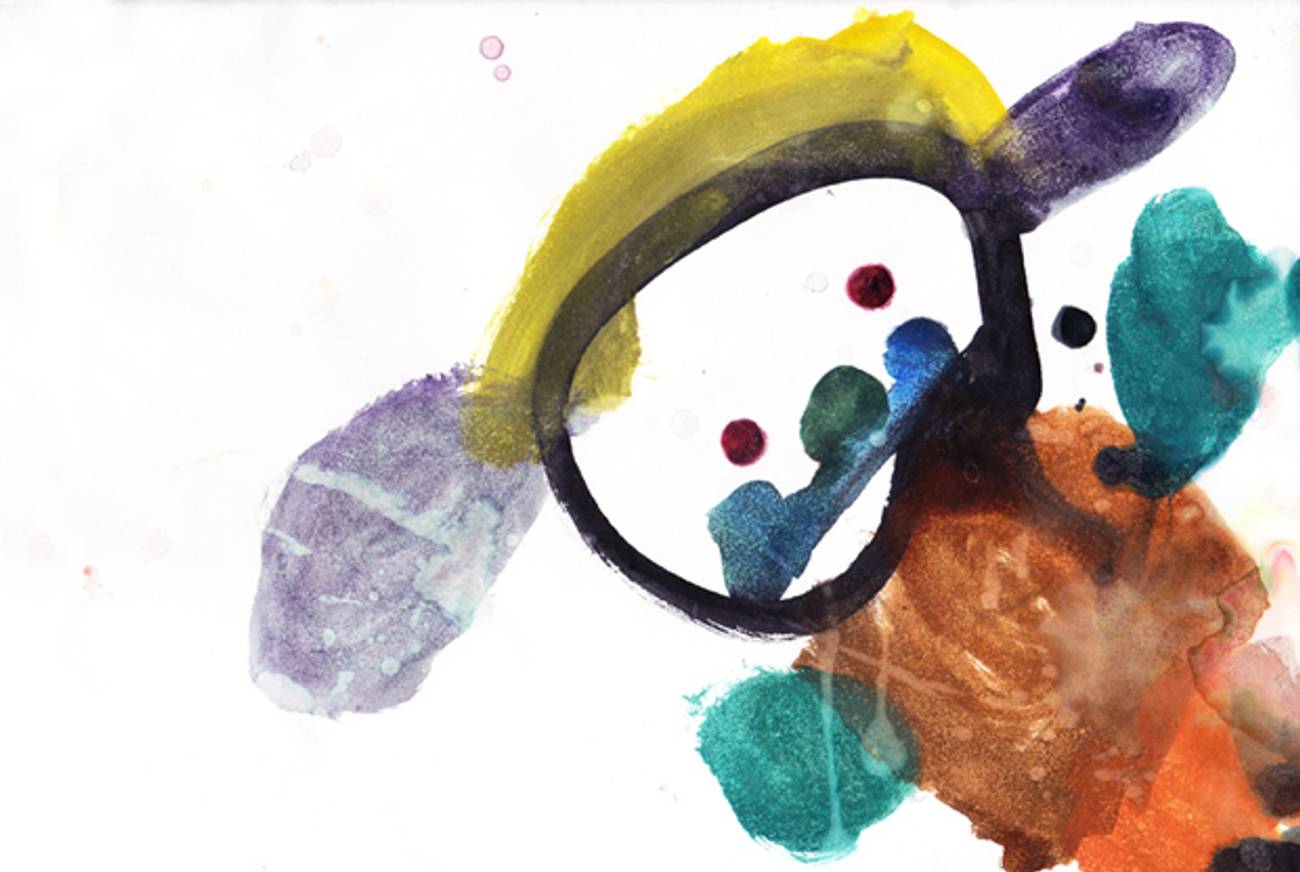Homemade Esthetics
Overeducated Yuppie parents gush about their kids’ mediocre artwork. But a new book about children’s art suggests that may not be a bad thing.




Not long ago, a friend cooed about how her preschooler drew his E’s: with endless little legs poking out, like the quills of the porcupine. “It’s as if he knows there are a bunch of lines there, but he doesn’t know how many, so he just keeps going!” she laughed, overcome by his cleverness. I rolled my eyes internally (take my word for it, it’s quite a trick) and smiled the smile of the smug: “Oh, honey,” I thought, “all kids do that.”
I had forgotten: I used to be the parent who cooed over the way my kid made an E.
Of course, it’s quite possible that the way children make a scribble or a spiky E is both mundane and miraculous. Our spawn go from little globs of protoplasm to actual people trying to communicate and express themselves through art. It doesn’t mean all their creations are special. Or rather, it sort of does. It does if it’s your kid and you’re watching his world expand exponentially every day.
The art critic Clement Greenberg (from whom I cribbed the title of this essay) once wrote, “Verdicts are the warp and woof of esthetic experience.” It’s natural to judge. Taste happens. But it doesn’t happen in a vacuum. Artists have to strive for what’s new, not rest on past laurels or do what’s easy. Then again, Greenberg was known for contradicting himself. On the one hand, he acknowledged that different people could come to different verdicts, but on the other he insisted that there was one correct answer: “You like it, that’s all, whether it’s a landscape or abstract,” he wrote. “You like it. It hits you. You don’t have to read it. The work of art—sculpture or painting—forces your eye.” But he also said, “We have differences but we’re not made different. If you don’t agree with me, you’re wrong.” Hmm.
Nowadays, we recognize that people come to art from a variety of experiences, perspectives, and identities and that it is human nature to believe that one’s own child’s art is brilliant and other kids’ art blows. But what I find interesting in parental art appreciation is the ability to hold two opposing ideas in mind at the same time and still be able to function. On some level, most of us know our own kid’s art really isn’t paradigm-shattering, but we also know that it symbolizes a wad of cells becoming a sentient artist. Even as you come to realize that every kid first draws a person by making a circle for a head and two vertical lines for legs, you still find that globule breathtaking when it’s hung up with a deli magnet on your own refrigerator. You love the artist and you love her output, and you know it’s mundane and you know it’s brilliant.
All that said, it is delightful to mock parents who discuss their children’s work in the hushed voices that convey being in the presence of genius. That is why I enjoyed “Is That a Picasso on Your Fridge?” by Dan Consiglio, auteur of the blog What My Kid’s Art Says. Unlike, say, I Am Better Than Your Kids—which makes fun of children’s art by pointing out their lack of fine motor skills—Consiglio’s book makes fun of art criticism more than bad kid pictures. We rave about our children’s artwork, even when we know it’s mediocre. But maybe that’s a good thing?
Critiquing a drawing by Alice, age 8, depicting Barbie shopping at a mall, Consiglio opines that it is a damning critique of consumerism; he compares the artist’s flat, one-dimensional style to Mayan wall painting. (“But there is no sacrifice to be had here,” he observes. “Barbie has bought everything, as evidenced by the multitude of bags surrounding her.”) Consiglio then moves on to the efforts of 5-year-old Sally, who made lines of dots on lined paper with the dot-paint markers found in every nursery-school classroom from here to eternity. Consiglio gushes: “If paradigm-shattering composer Philip Glass could paint, this is the masterpiece he would create. Sally’s gorgeous symmetry conceals blooming buds of chaos in much the same way that Glass’s repetitive notes conspire to create wholly other rhythms. Both artists display an otherworldly grasp of this simple human condition: repetition does not remove opportunity; it creates opportunity.” (True. But you missed the opportunity for a Damien Hirst joke.) And of the installation art created by Ty, age 3, of Rockford, Il.,—a yoga mat covered with toy cars—Consiglio writes: “Ty has managed to coalesce the chaos of the playroom with the serenity of nap time. Trucks, cars, planes—those symbols of male toddler aggression—line a yoga mat with rock garden precision. The result is oddly satisfying, a vision of delicate balance. Seconds after this photo was taken, Ty smashed the entire setup with a toy hockey stick before spilling his juice and soiling himself.”
It’s amusing, but it also makes us ask: Is our kid’s art great or derivative? Is art truly everywhere we look, or is criticism truly absurd? (The answer to all is yes.)
It seems to me that the parenting problem herein comes when we lose, um, perspective. What are the effects of overpraising a child’s artistic gifts, whether to ourselves (hello, ego) or to the child (hello, unrealistic overblown highly fragile self-esteem)? While I don’t agree with everything the educational theorist Alfie Kohn writes, I do like his approach to talking to kids about their work. Instead of praising it to the skies, he suggests, ask about the kid’s process or choices. (This is for when they’re past the miraculous globule-drawing stage, obviously.) Why’d they pick the colors they did? What’s happening in this part of the picture? Kohn would argue that we shouldn’t offer praise at all, but other educators tell us to praise effort, if it’s clear that the kid worked hard. (If it’s just another freaking rainbow fairy, feel free to smile politely as if you’re at a boring cocktail party.)
My kid Josie had the entertaining experience recently of being on a reality TV show about the making of art. (Adult artists were paired with children in the Studio in a School art program; the adults had to make a piece inspired by the child’s artwork.) Josie’s appearance pretty much consisted of her clutching her head and muttering, “We’re doomed.” (That’s my sunny little goth-to-be!) Later, when she saw the episode on TV, she was devastated to hear the artist she’d been paired with, whom she adored, tell the camera she wasn’t inspired by Josie’s work. But Josie got over it. Her takeaway: Reality TV is not real, and real artists should just make the art they want to make because most people won’t get it anyway. Works for me.
For parents, the challenge is nurturing our kids’ explorations in art without needing them to be kitchen-appliance Picassos. Josie loves to draw, paint, and sculpt. Who can say whether she’s “good” or not, and does it really matter? (Sorry, Clement Greenberg.) Art education is worthwhile for all kids, regardless of whether they’re actually gifted (a word you know I hate). An in-depth review of research on the value of art education, conducted by the President’s Committee on the Arts and the Humanities last year, confirmed what arts educators already know: Studying art helps kids feel engaged in school, is associated with improvements in reading and math, improves problem-solving skills, and encourages flexible thinking.
But it does more than that, I believe: One thing many testing-obsessed parents and governments forget is that it’s worthwhile for its own sake, not just because it makes kids do better on tests. (I’d add that the kids who already ace tests become more open-minded and reflective by taking art and by seeing that a classmate who may not kick butt on tests may have other gifts.) The arts are essential because they help kids see the world and themselves in a richer, more reflective way—whether or not they’re the next Helen Frankenthalers and Marc Chagalls.
Marjorie Ingall is a columnist for Tablet Magazine, and author of Mamaleh Knows Best: What Jewish Mothers Do to Raise Successful, Creative, Empathetic, Independent Children.
Marjorie Ingall is a former columnist for Tablet, the author of Mamaleh Knows Best, and a frequent contributor to the New York Times Book Review.